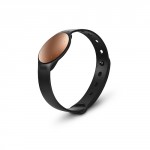Hands on with the Microsoft Band 2
There has been a huge influx of smartwatches, smart bands and fitness trackers recently, and with so much market saturation, what does it take to stand out amongst the crowd? It generally comes down to 3 main areas: aesthetic appeal, functionality and easy-of-use. The Microsoft Band 2 is a pretty good contender for all 3 of these, and should definitely be one to watch.
The Microsoft Band 2 is a smart band designed to help you increase your fitness and productivity levels. It has 11 different sensors to track your heart rate, calorie burn, sleep quality, and plenty of different sports and exercises. Coupled with the smartphone app, it also gives you insights based on the data it collects.

To start with, it’s one of the most aesthetically pleasing bands I’ve used. It’s utilises a minimalist and sleek design with a curved AMOLED display which wraps comfortably around your wrist. Compared to the previous Microsoft Band, the new model has a metallic finish around the edges which makes it feel much more like a luxury product. There is a power button and an ‘action’ button on the side of the watch face, but apart from that it is controlled using only the touchscreen. The battery in the Micorsoft Band 2 is remarkable considering the bright display, and I managed to get around two days of use out of it before recharging. There is a metallic sliding mechanism on the back which you use to clip it onto your wrist, and although it’s very easy to put on and take off, this also means it could be easily pick-pocketed in a crowded area. The matte chrome effect also means it’s easy to scratch this clip, but that is a minor issue.

Using the Microsoft Band 2 is straightforward. You can raise it to your face to automatically switch on the screen to show you to the time and date, and then fully switch it on by pressing the power button. You can then either slide the screen to view all of your ‘tiles’ (built-in applications), or tap the screen to see statistics such as steps taken, calories burnt and heart rate. Opening one of the tiles is done with a simple tap, and then you can navigate them using the touchscreen controls. The action button is used for multiple things, but mainly to start and pause workouts and alarms. Overall the user interface is intuitive and efficient, meaning you can easily navigate it on the move. The only issue I’ve found is that the watch only works on a horizontal resolution, making it hard to navigate if you like to wear the band on the outside of your wrist. Although I initially started using it on the outside myself, I soon switched to having it on the inside of my wrist and found it to be just as comfortable.

One of the best features compared to other bands and smartwatches is that it works with iPhone and Android, as well as Microsoft’s own phones. I personally tested it on an iPhone and found the experience to be a lot smoother than expected. I simply had to install the Microsoft Health app, sync it with my Microsoft Band 2 and then I was off and away. The Microsoft Health app allows you to customise the colours and tiles, check through your daily insights and create custom workouts. Syncing your phone to the band also lets you push notifications, texts, calls, emails, and plenty of other data to your band. Although this is great, unfortunately you can’t reply to any messages using the band, unless you have a Microsoft phone. There is also a small microphone built into the band which is rendered useless with Android and iOS.

There’s a range of tiles which you can install onto your Microsoft Band 2, ranging from productivity apps like email and texts to social networks like Twitter and Facebook. There is also a selection of fitness-oriented apps for specific sports such as golf, running, cycling and general fitness. These applications use all of the sensors to monitor your workouts and provide you with great insights about your fitness and progress. There is also a guided workout application which allows you to browse and download workout routines from different sources, and then have them displayed with timers and instructions on your band. I found the band incredibly useful during my trips to the gym, and it ended up saving me a lot of time faffing to find YouTube video workouts.
Despite a few minor issues and features missing from iOS and Android, the Microsoft Band 2 proves to be a capable contender in the wearable tech marketplace. Compared to the more expensive wearables, the Microsoft Band 2 retails at a much more reasonable £199.99. Get ahead of the curve and find out more details about the Microsoft Band 2 on the Microsoft website.





